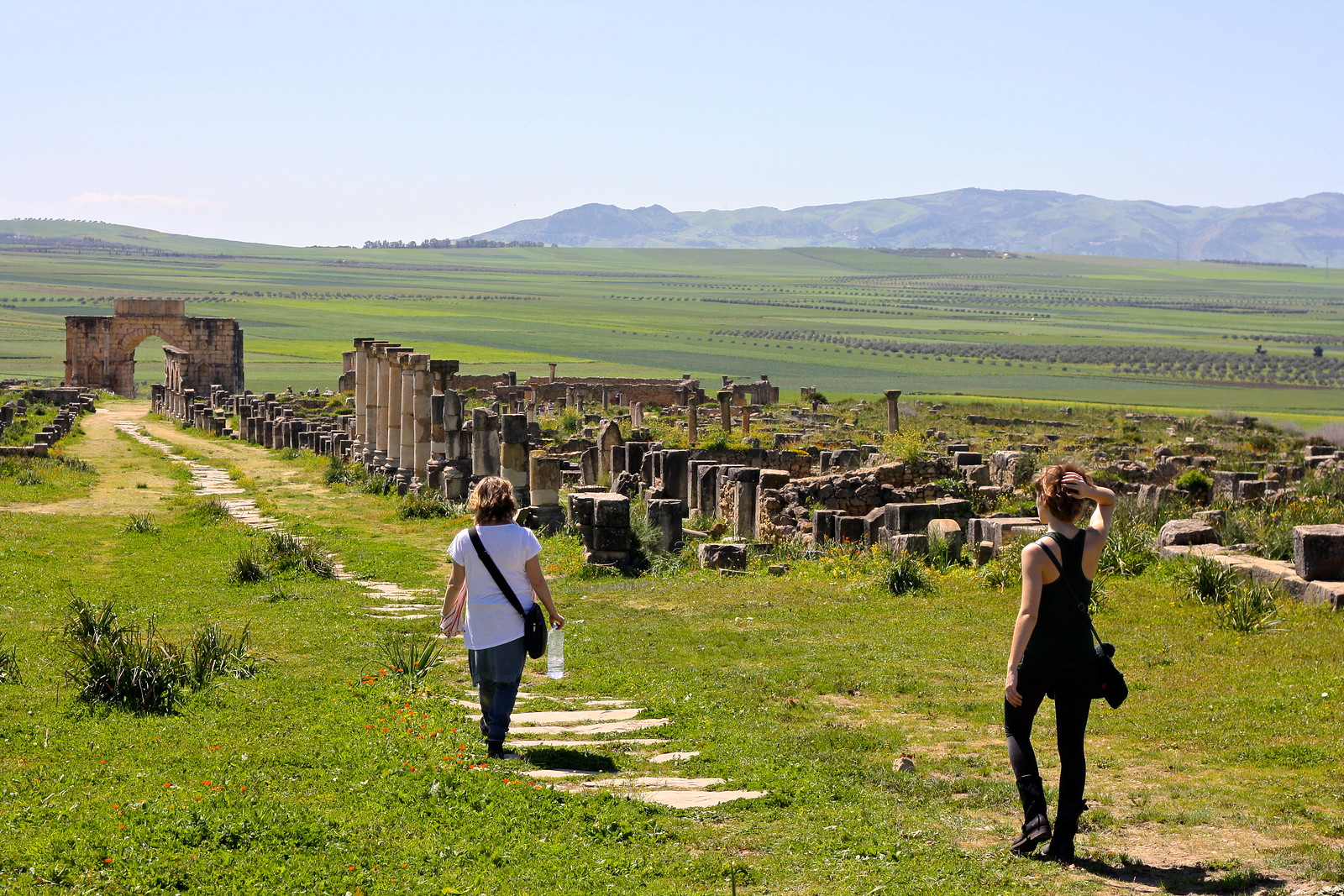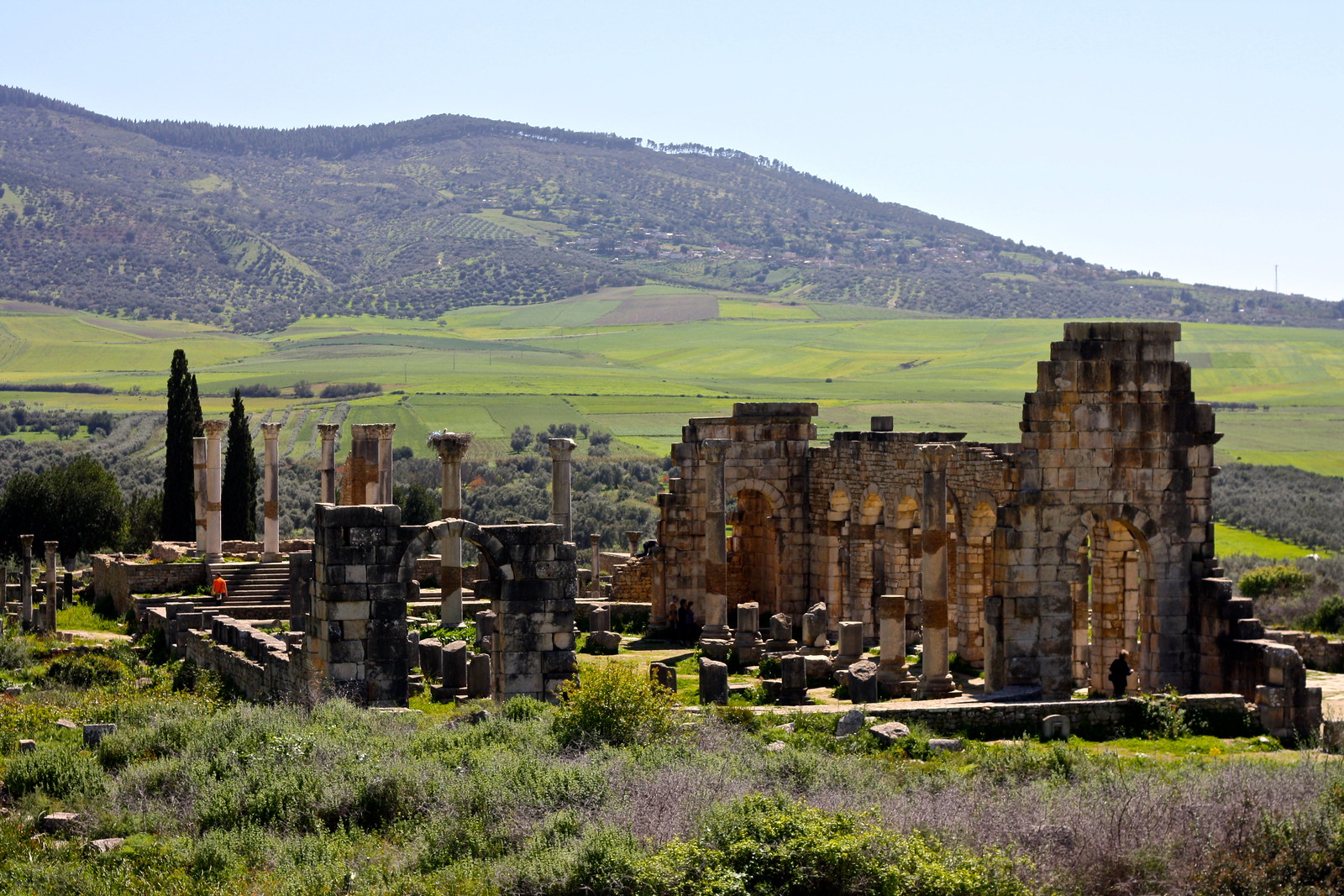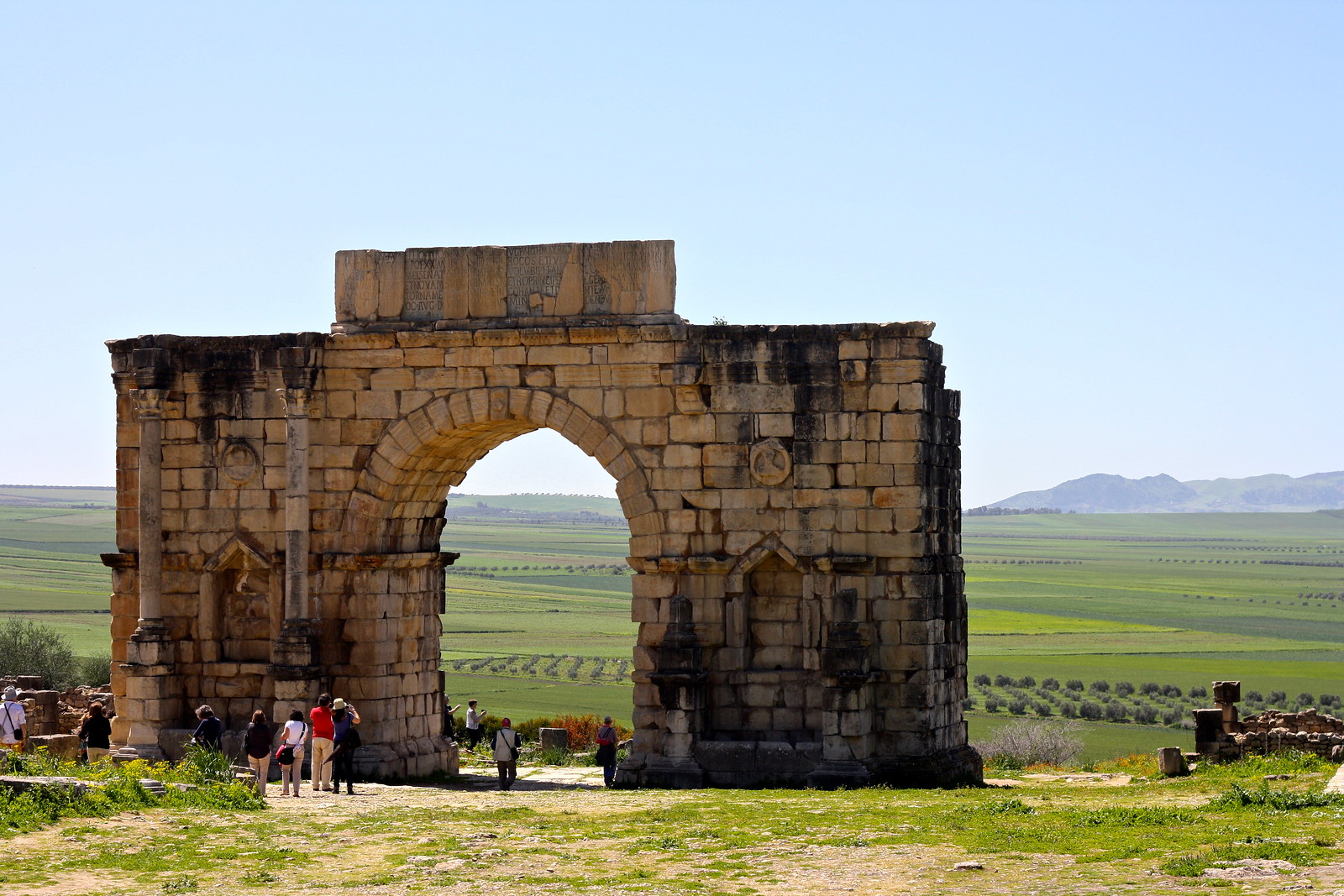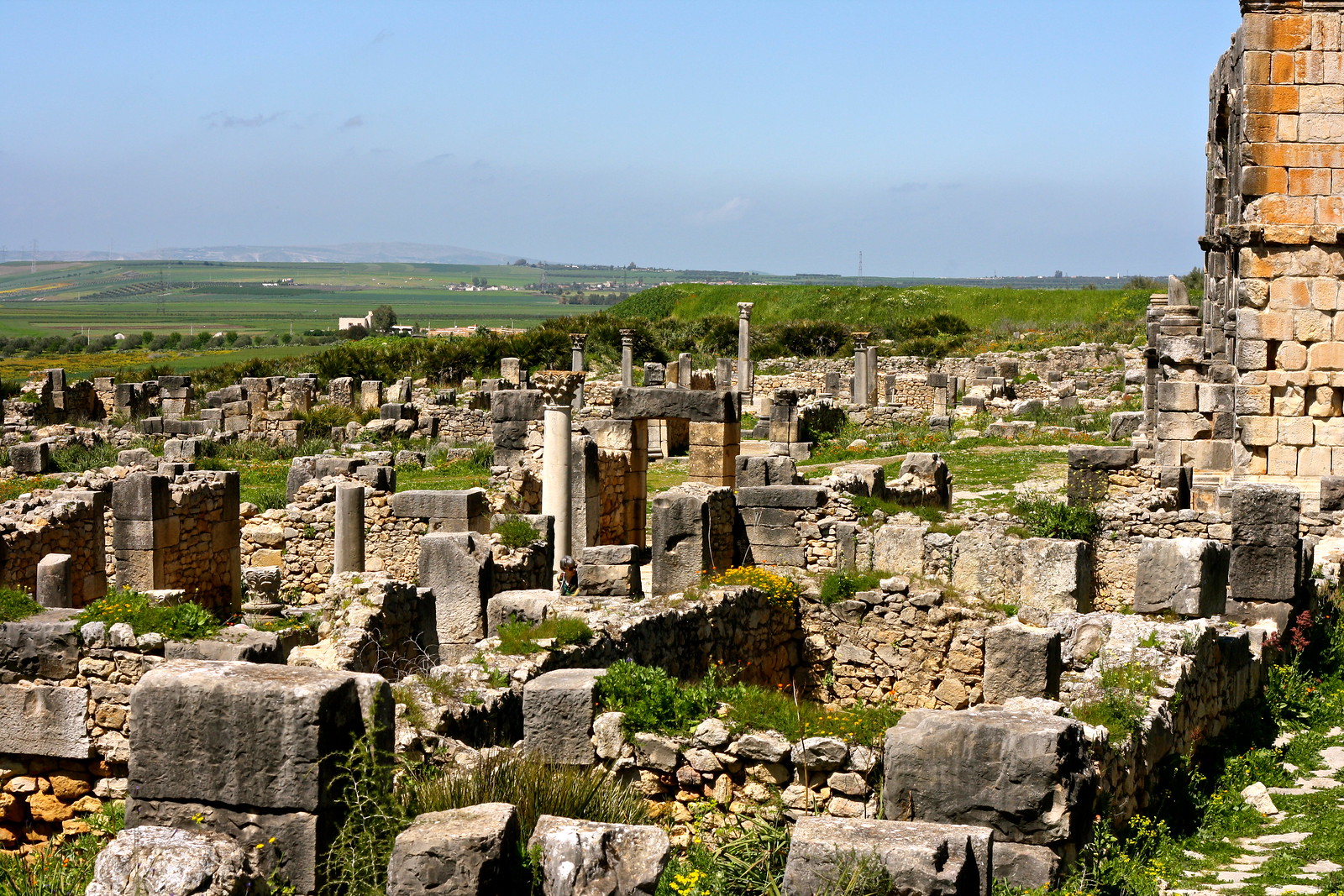FAQ about Volubilis, Morocco: Roman Ruins in North Africa
Although the fascinating mix of Arab and Berber cultures was what drew me to Morocco this spring, something else spoke to my inner history major: the crumbling skeleton of a once-flourishing Roman city. This place, called VOLUBILIS by the Romans and Oualili by the Berbers, is one of the most important Roman sites in north Africa, yet many tourists to Morocco have never even heard of the ruins or shy away from making a day-trip from the imperial city of Meknes. Read on to learn why it’s worth putting on your Moroccan itinerary.
Okay this one’s a little tricky. In Classical Latin it would have been pronounced “woe-LOO-bee-lees” [woˈlu.bi.lis], not far removed from the Berber Oualili or Walili. For English-speakers, however, it’s probably fine to voice the V since that’s what the French do as well. Go ahead—you can say it out loud if you like! “voe-LOO-bee-lees” with the stress on the third-to-last syllable, just like in the word “democracy.”
Volubilis was an important city of about 20,000 people on the frontiers of the empire, serving as a capital of sorts for the Mauretania province that corresponds to modern-day Morocco. The Romans didn’t found Volubilis as much as they took over the settlement—which had been inhabited by Neolithic people, Berbers, and Phoenicians—in the middle of the 1st century CE. Under Roman administration, the city gained a governmental basilica and a central forum, ultimately receiving a triumphal arch dedicated to the North African emperor Caracalla who made Volubilitians (?) Roman citizens.
After the fall of the empire and barbarian invasions, the city carried along swimmingly, speaking Latin and going to church all the way down to the time of the Muslims in the 8th century, when Arabic and Islam were introduced.
In 788, a man fleeing Arabia with a bounty on his head named Idriss (who also happened to be a great-grandson of Muhammad) came to Volubilis, where he was made the local imam and a political leader. This is traditionally considered the “founding” of Morocco, as the Idrissid dynasty was the first line of Moroccan kings. Idriss made plans to establish a new capital at Fez, but he was assassinated before he could see them through. Fez ultimately was built under the reign of his son, Idriss II, and Volubilis slowly declined as Fez and nearby Moulay Idriss Zerhoun drew prestige and people away, respectively. By the second millennium CE, it was deserted.
Once abandoned, Volubilis became sort of informal quarry for local building projects—the palaces of Meknes, for example—but after the same earthquake that flattened Lisbon in 1755, little was left standing and the main monumental buildings we see today were in shambles.
Although time has not been kind to Volubilis, there is still quite a lot left and authorities both colonial and contemporary have done a lot to restore the city. The three main sights are the forum—the public square—the basilica—a cathedral-shaped administrative building—and the triumphal arch dedicated to Emperor Caracolla. These have all been reconstructed from stones and blocks following French and Moroccan efforts in the last century.
Remarkably, some vast and colorful mosaics still cover the floors of courtyards and pools in the remains of private homes across the city; you can stroll down the main streets, crossing thresholds here and there to see massive, whimsical designs that would have taken many, many hours to complete by hand.
The Tingis Gate stands on the outskirts of town, up the hill along the Decumanus Maximus or Main Street. A lanky, three-arched structure, it was rebuilt during the restorations of the forum, basilica, and triumphal arch. From here you can really get a feel for the whole sweep of the town as the northeastern side the site is empty and at a higher elevation from the center.
What I enjoyed the most was simply being able to explore the ruins with only a few ropes cordoning off the most significant mosaics; you could just crawl over the stones and balance along rows of blocks—as long as the guardian standing on a hill in the center didn’t blow his whistle at you!
Thankfully there were few tourists at Volubilis—a German tour group here, some Spaniards there—so I felt free to photograph and appreciate the ruins in the quiet, warm sunlight.
You can get here via public transportation a couple of different ways. You can take the 25km bus ride from Meknes to Moulay Idriss Zerhoun, a town that is a 5km (one-hour) walk from the ruins, or you can do what I did and get a grand taxi (interurban taxi) from Meknes directly to Volubilis.
I was really fortunate because I was able to share the price of getting there with three other Americans who graciously let me join in on the taxi they had arranged through our hotel. For 125 dirhams each (about 15 bucks), the driver took us to Volubilis, let us roam around, drove us over to Moulay Idriss where we had lunch, and took us back to Meknes, all within the span of four hours, so not a bad deal at all.
Would you go out of your way to see Roman ruins in the Arab world, like Leptis Magna in Libya or Alexandria in Egypt? Or do you prefer the living culture to the silent past? Comment below!

 |
| Strolling down the Decumanus Maximus |
How do you say “boloo-blah-blah”?
 |
| Roman inscription recording the name of the city |
Okay this one’s a little tricky. In Classical Latin it would have been pronounced “woe-LOO-bee-lees” [woˈlu.bi.lis], not far removed from the Berber Oualili or Walili. For English-speakers, however, it’s probably fine to voice the V since that’s what the French do as well. Go ahead—you can say it out loud if you like! “voe-LOO-bee-lees” with the stress on the third-to-last syllable, just like in the word “democracy.”
What was Volubilis?
 |
| The basilica (foreground) and the forum (background) |
Volubilis was an important city of about 20,000 people on the frontiers of the empire, serving as a capital of sorts for the Mauretania province that corresponds to modern-day Morocco. The Romans didn’t found Volubilis as much as they took over the settlement—which had been inhabited by Neolithic people, Berbers, and Phoenicians—in the middle of the 1st century CE. Under Roman administration, the city gained a governmental basilica and a central forum, ultimately receiving a triumphal arch dedicated to the North African emperor Caracalla who made Volubilitians (?) Roman citizens.
 |
| Arch of Caracalla |
After the fall of the empire and barbarian invasions, the city carried along swimmingly, speaking Latin and going to church all the way down to the time of the Muslims in the 8th century, when Arabic and Islam were introduced.
Why did it fall into ruins?
 |
| Ruins |
In 788, a man fleeing Arabia with a bounty on his head named Idriss (who also happened to be a great-grandson of Muhammad) came to Volubilis, where he was made the local imam and a political leader. This is traditionally considered the “founding” of Morocco, as the Idrissid dynasty was the first line of Moroccan kings. Idriss made plans to establish a new capital at Fez, but he was assassinated before he could see them through. Fez ultimately was built under the reign of his son, Idriss II, and Volubilis slowly declined as Fez and nearby Moulay Idriss Zerhoun drew prestige and people away, respectively. By the second millennium CE, it was deserted.
Once abandoned, Volubilis became sort of informal quarry for local building projects—the palaces of Meknes, for example—but after the same earthquake that flattened Lisbon in 1755, little was left standing and the main monumental buildings we see today were in shambles.
What is left today?
 |
| Mosaics depicting dolphins |
Although time has not been kind to Volubilis, there is still quite a lot left and authorities both colonial and contemporary have done a lot to restore the city. The three main sights are the forum—the public square—the basilica—a cathedral-shaped administrative building—and the triumphal arch dedicated to Emperor Caracolla. These have all been reconstructed from stones and blocks following French and Moroccan efforts in the last century.
Remarkably, some vast and colorful mosaics still cover the floors of courtyards and pools in the remains of private homes across the city; you can stroll down the main streets, crossing thresholds here and there to see massive, whimsical designs that would have taken many, many hours to complete by hand.
The Tingis Gate stands on the outskirts of town, up the hill along the Decumanus Maximus or Main Street. A lanky, three-arched structure, it was rebuilt during the restorations of the forum, basilica, and triumphal arch. From here you can really get a feel for the whole sweep of the town as the northeastern side the site is empty and at a higher elevation from the center.
What I enjoyed the most was simply being able to explore the ruins with only a few ropes cordoning off the most significant mosaics; you could just crawl over the stones and balance along rows of blocks—as long as the guardian standing on a hill in the center didn’t blow his whistle at you!
Thankfully there were few tourists at Volubilis—a German tour group here, some Spaniards there—so I felt free to photograph and appreciate the ruins in the quiet, warm sunlight.
How do I get there?
 |
| Grand taxi from Meknes |
You can get here via public transportation a couple of different ways. You can take the 25km bus ride from Meknes to Moulay Idriss Zerhoun, a town that is a 5km (one-hour) walk from the ruins, or you can do what I did and get a grand taxi (interurban taxi) from Meknes directly to Volubilis.
I was really fortunate because I was able to share the price of getting there with three other Americans who graciously let me join in on the taxi they had arranged through our hotel. For 125 dirhams each (about 15 bucks), the driver took us to Volubilis, let us roam around, drove us over to Moulay Idriss where we had lunch, and took us back to Meknes, all within the span of four hours, so not a bad deal at all.
Would you go out of your way to see Roman ruins in the Arab world, like Leptis Magna in Libya or Alexandria in Egypt? Or do you prefer the living culture to the silent past? Comment below!
